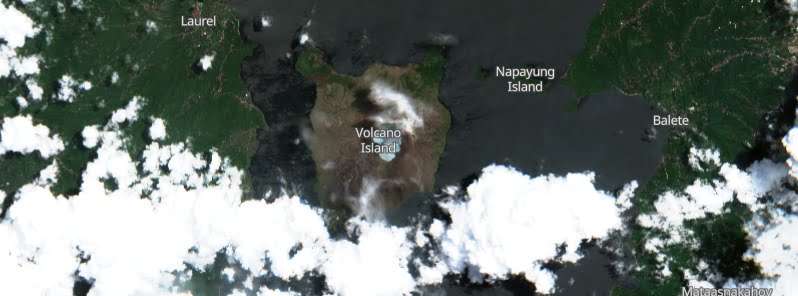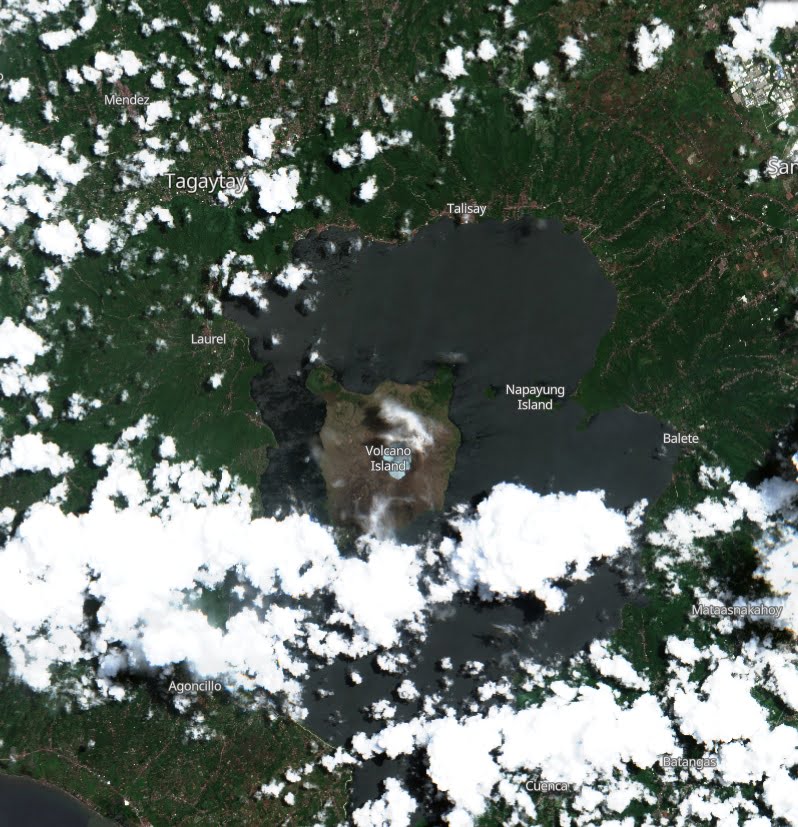Two phreatic bursts at Taal volcano in Batangas Province, Philippines

The Taal Volcano in Batangas Province, Philippines, experienced two phreatic bursts in 24 hours to 21:00 UTC on June 29, 2023, as well as 9 volcanic earthquakes and 5 volcanic tremors. Alert Level 1 is in effect; entry into Taal Volcano Island PDZ is forbidden.
Initial reports from the Disaster Risk Reduction and Management Council (DRRMC) in Region 4-A, also known as Calabarzon (Cavite, Laguna, Batangas, Rizal, and Quezon), state that the eruption occurred around 12:54 PHT and lasted for two minutes. The eruption, described as phreatic, propelled a plume of white ash and steam to a height of about 250 m (820 feet) above the crater. The plume was directed southwest, according to the DRRMC-Calabarzon.1
The director of the Philippine Institute of Volcanology and Seismology (PHIVOLCS), Teresito “Toto” Bacolcol, clarified the nature of the eruption in a statement to The Manila Times. “What happened in Taal was just a phreatic burst. This happens when a hot material comes into contact with water, producing steam,” Bacolcol explained. “The burst was just low and only 250 meters. It’s just over its crater, so there is no need to evacuate people living beyond the permanent danger zone.”

In an advisory issued at 13:00 LT on June 4, 2023, PHIVOLCS noted a significant increase in degassing activity from Taal volcano. This activity was marked by the visible upwelling of volcanic fluids in the Main Crater Lake that produced voluminous steam-rich plumes. These plumes rose to 3 000 m (9 842 feet) above the Taal Volcano Island, leading to the formation of considerable volcanic smog, also known as vog, over the Taal Caldera.2
Vog, a significant concern due to its health implications, was reported by residents of the Municipalities of Balete, Laurel, and Agoncillo in Batangas. This comes after 5 831 tonnes/day of volcanic sulfur dioxide (SO2) gas emission from the Taal Main Crater on June 1, 2023, a figure that surpassed the previous month’s average of 3 556 tonnes/day (3 917.6 tons/day).
As a reminder, vog consists of fine droplets containing volcanic gas such as SO2, which is acidic and can cause irritation of the eyes, throat, and respiratory tract, with severities depending on the gas concentrations and durations of exposure.
On June 28, PHIVOLCS registered 7 489 tonnes/day of SO2.
Geological summary
Taal is one of the most active volcanoes in the Philippines and has produced some of its most powerful historical eruptions. Though not topographically prominent, its prehistorical eruptions have greatly changed the topography of SW Luzon.
The maximum depth of the lake is 160 m (525 feet), and several eruptive centers lie submerged beneath the lake. The 5 km (3.1 miles) wide Volcano Island in north-central Lake Taal is the location of all historical eruptions.
The island is composed of coalescing small stratovolcanoes, tuff rings, and scoria cones that have grown about 25% in the area during historical time. Powerful pyroclastic flows and surges from historical eruptions have caused many fatalities.3
References:
1 Taal Volcano erupts – The Manila Times – June 29, 2023
2 Increased degassing activity at Taal volcano, vog reported in Balete, Laurel, and Agoncillo, Philippines – The Watchers – June 5, 2023
3 Taal – Geological summary – GVP
Featured image: Taal volcano on June 1, 2023. Credit: Copernicus EU/Sentinel-2, EO Browser, The Watchers

Commenting rules and guidelines
We value the thoughts and opinions of our readers and welcome healthy discussions on our website. In order to maintain a respectful and positive community, we ask that all commenters follow these rules.